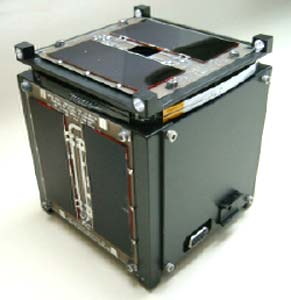Thank you very much for visiting Gunter's Space Page. I hope that this site is useful and informative for you.
If you appreciate the information provided on this site, please consider supporting my work by making a simple and secure donation via PayPal. Please help to run the website and keep everything free of charge. Thank you very much.
CP 1

CP 1 [Cal Poly]
The Cal Poly Picosatellite Project (PolySat) was founded in 1999 and involves a multidisciplinary team of undergraduate and graduate engineering students working to design, construct, test, launch, and operate a CubeSat.
CP1, the first satellite developed at Cal Poly, is designed with the objective of providing a reliable bus system to allow for flight qualification of a wide variety of small sensors and attitude control devices. For the first launch, CP1 carries a sun sensor developed by Optical Energy Technologies and an experimental magnetorquer developed at Cal Poly by undergraduate students. The test build of CP1 has undergone vibration and thermal-vacuum qualification testing at NASA worst-case qualification levels.
The launch of CP1 and CP2 was not successful, as the Dnepr failed 86 sec after launch.
| Nation: | USA |
|---|---|
| Type / Application: | Technology |
| Operator: | Cal Poly Picosatellite Project (PolySat) |
| Contractors: | Cal Poly Picosatellite Project (PolySat) |
| Equipment: | |
| Configuration: | CubeSat (1U) |
| Propulsion: | None |
| Power: | Solar cells, batteries |
| Lifetime: | |
| Mass: | 1 kg |
| Orbit: |
| Satellite | COSPAR | Date | LS | Launch Vehicle | Remarks | |
|---|---|---|---|---|---|---|
| CP 1 (K7RR-Sat) | 2006-F03 | 26.07.2006 | Ba LC-109/95 | F | Dnepr | with BelKa 1, Baumanets 1, Unisat 4, PicPot, CP 2, HAUSAT 1, ICECube 1, ICECube 2, ION, KUTESat-Pathfinder, Mea Huaka'i, MEROPE, Ncube 1, Rincon 1, SACRED, SEEDS, AeroCube 1 |
References:
- Cal Poly: CP1
